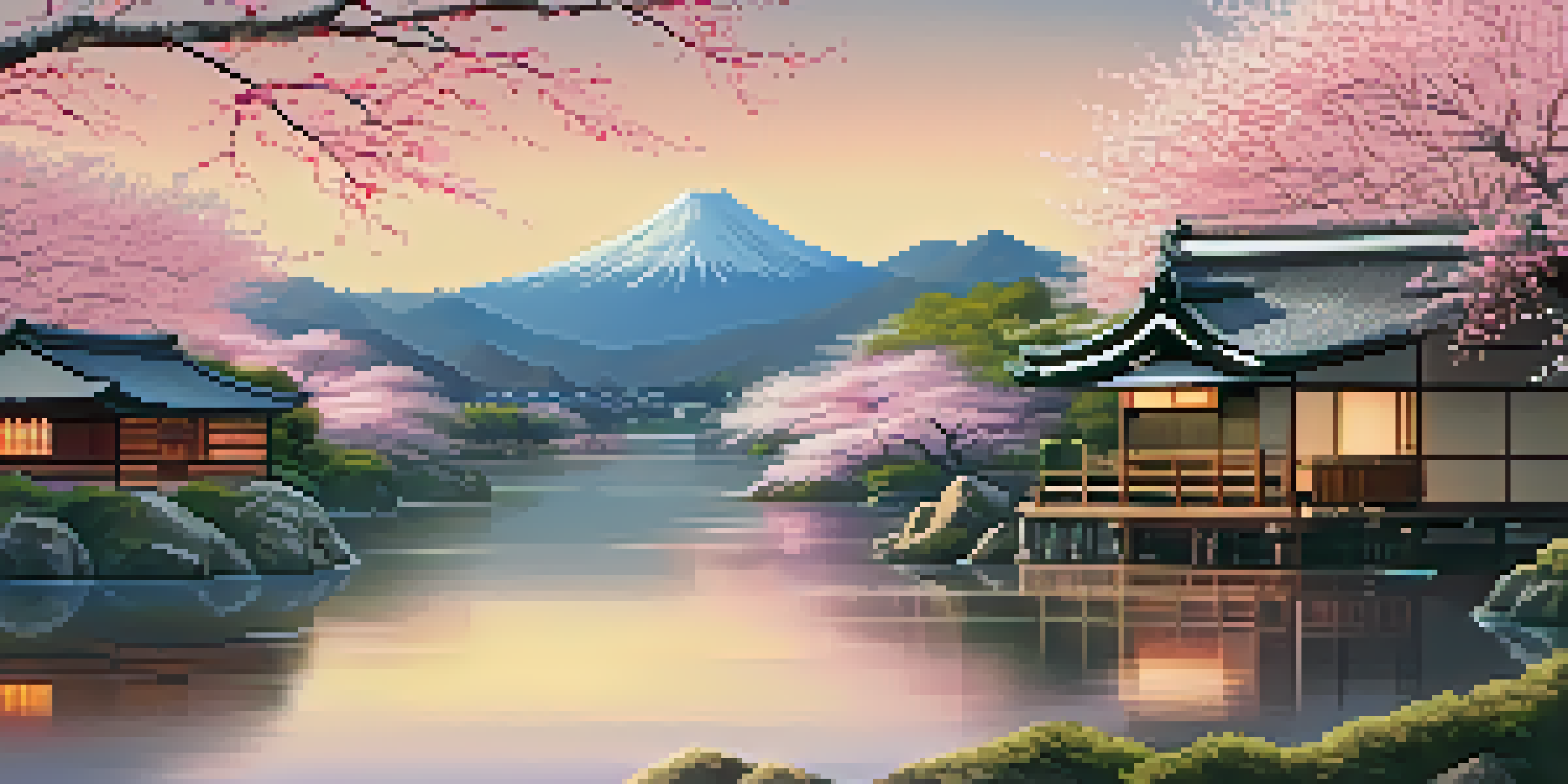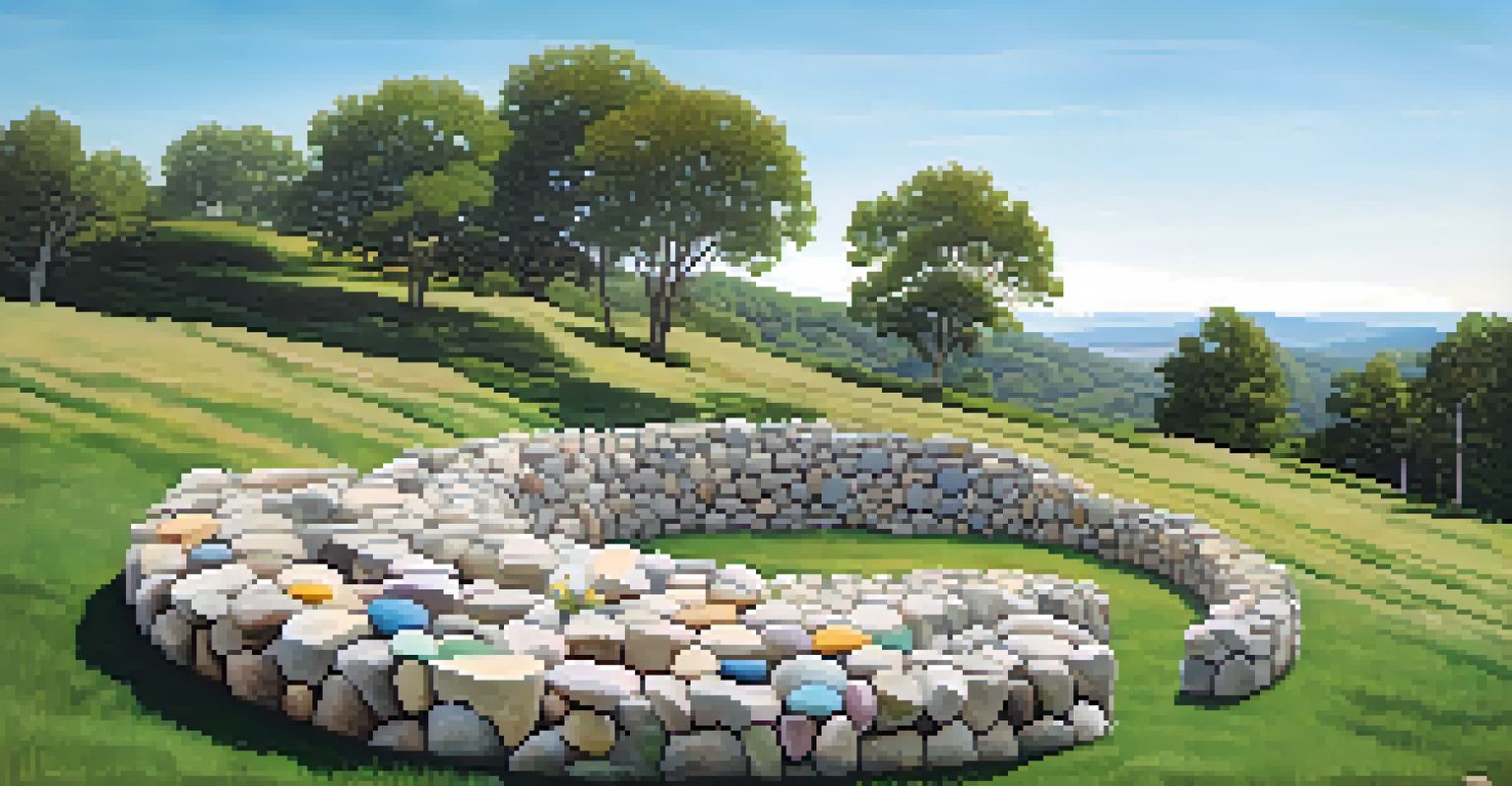Cultural Interpretations of Nature in Painting

Understanding Nature Through Cultural Lenses
Nature has always been a profound source of inspiration for artists across cultures. Each culture interprets and represents nature in unique ways, reflecting their values, beliefs, and experiences. For instance, while Western art often emphasizes the beauty and grandeur of landscapes, Eastern art might focus on harmony and the interconnectedness of all living things.
Nature does not hurry, yet everything is accomplished.
These differing perspectives are not just stylistic choices; they reveal deeper cultural narratives. In many Indigenous cultures, nature is seen as a living entity, deserving respect and reverence. This contrasts with more industrialized cultures, where nature is often viewed as a resource to be exploited.
By examining how various cultures depict nature in their art, we gain insight into their worldviews. This exploration encourages a deeper appreciation for the diversity of human experience and the myriad ways we relate to the natural world.
The Role of Symbolism in Nature Paintings
Symbolism plays a crucial role in how nature is depicted in paintings. In many cultures, elements of nature symbolize deeper meanings. For example, in Chinese art, bamboo often represents resilience and flexibility, while cherry blossoms symbolize the fleeting nature of life.

Artists use these symbols to convey messages that resonate with their audiences. This use of symbolism allows viewers to engage with the artwork on multiple levels, encouraging them to think beyond the surface. It invites them to ponder the significance of the natural elements depicted.
Cultural Perspectives on Nature
Different cultures interpret nature uniquely, revealing their values and worldviews through art.
In this way, symbolism enriches the viewer's experience, creating a dialogue between the painting and the observer. This ongoing conversation highlights the connection between culture, nature, and human emotion.
Nature in Ancient Art: A Reflection of Beliefs
In ancient civilizations, nature often played a central role in artistic expression. For instance, the Egyptians depicted the Nile River as a giver of life, reflecting its importance to their society. Similarly, ancient Greek art celebrated nature's beauty through depictions of gods and goddesses associated with natural elements.
Art is the most beautiful of all lies.
These artworks served not only as decoration but also as a means of communicating cultural beliefs. Nature was intertwined with spirituality and daily life, influencing how artists approached their subjects. The reverence for nature seen in these pieces underscores its significance in shaping cultural identity.
Exploring ancient art reveals how foundational nature has been in the development of human culture. It reminds us that our relationship with the natural world has deep historical roots that continue to influence modern interpretations.
Impressionism: Capturing Nature's Ephemeral Beauty
The Impressionist movement, which emerged in the late 19th century, marked a significant shift in how artists approached nature. Instead of focusing on detailed realism, Impressionists like Monet and Renoir sought to capture the fleeting qualities of light and color in natural scenes. Their paintings often depict landscapes, gardens, and water scenes, emphasizing the ever-changing nature of the environment.
This approach allows viewers to experience nature's beauty in a more immediate and emotional way. The loose brush strokes and vibrant colors evoke a sense of movement and life, inviting the audience to feel the atmosphere of the moment. Impressionism celebrates the transient aspects of nature, reminding us to appreciate its beauty in the present.
Symbolism Enriches Art Experience
Symbolism in nature paintings invites viewers to engage with deeper meanings and emotions.
By focusing on these ephemeral qualities, Impressionist artists encourage a deeper emotional connection between the viewer and the natural world. This shift in perspective has had a lasting impact on how nature is represented in art today.
Nature in Japanese Art: A Harmony of Elements
Japanese art, particularly traditional forms like ukiyo-e, often emphasizes the harmonious relationship between humans and nature. Artists like Hokusai and Hiroshige portrayed landscapes that highlight nature's beauty while also integrating human figures in a way that reflects coexistence. This approach underscores the belief in nature's central role in everyday life.
The use of color, composition, and perspective in Japanese art creates a sense of tranquility and balance. For instance, the depiction of cherry blossoms is not only aesthetic but also deeply symbolic, representing the transient nature of life. This duality encourages viewers to reflect on their own relationship with the natural world.
By exploring the harmonious representation of nature in Japanese art, we see a cultural perspective that values balance and respect for the environment. This philosophy resonates with contemporary discussions on sustainability and our connection to nature.
Contemporary Art: Nature as a Social Commentary
In contemporary art, nature is often used as a medium for social commentary. Artists like Andy Goldsworthy create installations using natural materials, drawing attention to environmental issues. By using nature itself as a canvas, they challenge viewers to reconsider their impact on the environment.
These artworks often provoke thought and inspire action, highlighting the urgent need for environmental awareness. They serve as a reminder that nature is not just a backdrop for artistic expression but an integral part of the conversation about our future. This approach encourages a more profound engagement with the issues surrounding nature today.
Nature as a Contemporary Commentary
Modern artists use nature to address social and environmental issues, prompting reflection and action.
Through contemporary interpretations of nature, artists are using their platforms to address critical challenges. This evolution in artistic expression reflects a growing awareness of our responsibilities towards the environment and the role art can play in advocating for change.
The Future of Nature in Art: A Cultural Exploration
As we move forward, the representation of nature in art will continue to evolve, influenced by societal changes and technological advancements. Artists are increasingly exploring themes of sustainability and climate change, utilizing their work to provoke dialogue about our relationship with the environment. This shift reflects a growing consciousness about the impact of human activity on nature.
Moreover, the blending of traditional and contemporary techniques allows for a richer exploration of nature's significance across cultures. Artists today have access to a wealth of cultural references, enabling them to weave diverse interpretations of nature into their work. This fusion creates a vibrant tapestry of ideas that speaks to a global audience.

The future of nature in art promises to be a dynamic interplay between culture, technology, and environmental awareness. As artists continue to explore this relationship, they will inspire new generations to appreciate and protect the natural world.